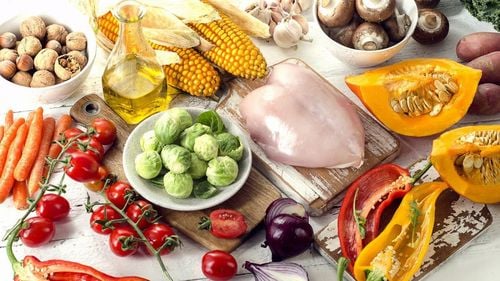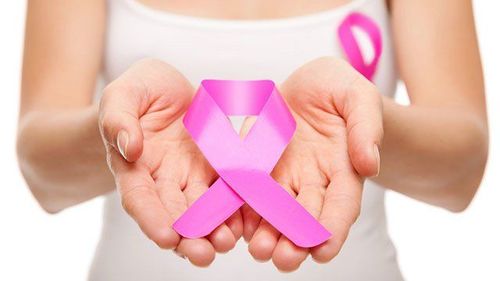This is an automatically translated article.
Certain foods, vitamins, minerals and other nutrients that we eat can increase or decrease the risk of cancer. This article will cover cancer-fighting foods and foods that may increase your risk of cancer.
1. Plant-based food group These foods contain natural substances called phytonutrients. For example, carotenoids, or carotenes, are found in red, orange, and yellow vegetables and some dark green vegetables.
Polyphenols, found in herbs, spices, vegetables, tea, coffee, chocolate, nuts, apples, onions, and other plants. Allium compounds, found in chives, garlic, leeks, and onions. Phytonutrients found in fruits and vegetables are most likely to work together to reduce cancer risk, rather than a specific food ingredient influencing the risk.
Fruits and vegetables have the ability to reduce the risk of several types of cancer, including: head and neck cancer, esophageal cancer, stomach cancer, lung cancer, pancreatic cancer, adenocarcinoma prostate .
Certain types help regulate hormones, such as estrogen , lycopene and these carotene are found in tomato products. Other important sources of lycopene include pink grapefruit, watermelon, and apricots. Studies show that lycopene may protect against cancer of the lung, prostate, colon, mouth, and throat (oral cavity) esophagus.
Some plant-based foods are good at preventing cancer such as:
1.1 Vegetables Regularly eating cruciferous foods has been linked to a reduced risk of cancer. Studies show that cruciferous vegetables protect against head and neck cancers, esophageal cancer, and stomach cancer. Several laboratory studies show that cruciferous vegetables help regulate cancer-fighting enzymes. Studies have also shown that cruciferous vegetables can block cancer cell growth in other ways.
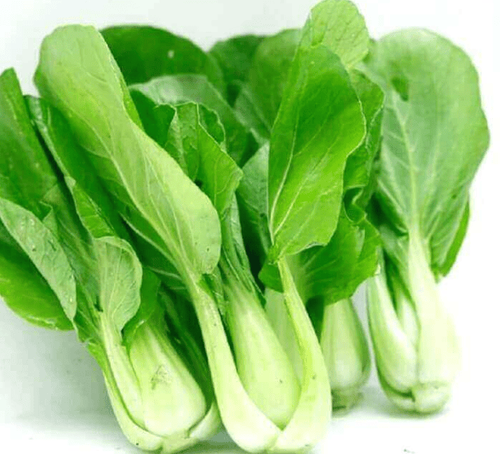
Các loại rau họ cải có thể giúp người dùng giảm nguy cơ mắc ung thư
1.2 Soy Soybeans contain unique phytonutrients. Lab studies show that these substances help protect against certain types of cancer. Current studies show that eating up to 3 servings of soy foods, such as edamame, tofu, soy milk, and miso can reduce the risk of breast cancer.
1.3 Tea If you enjoy sipping tea, you'll be happy to know that it's also a form of cancer-fighting food. Like many plant-based foods, teas containing flavonoids, especially kaempferol, have shown protective effects against cancer. A large study that evaluated the intake of kaempferol in more than 66,000 women found that those who consumed the most kaempferol had the lowest risk of ovarian cancer.
A separate study found a link between flavonoid consumption and a reduced risk of breast cancer. The study, which involved nearly 3,000 people, found that postmenopausal women with the most flavonoids were 46 percent less likely to develop breast cancer than those with the least.
However, flavonoid consumption did not affect breast cancer risk in premenopausal women. If you are a tea drinker, enjoy hot tea to keep you warm in winter, and iced tea to cool you down in summer. So enjoy tea all year round to boost cancer prevention.
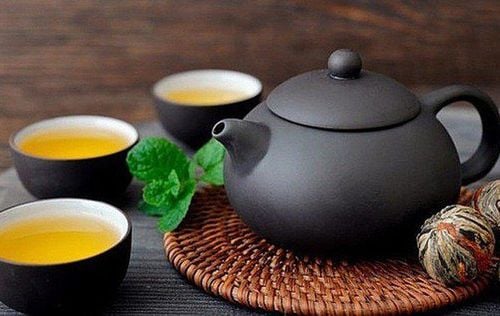
Trà cũng là một dạng thực phẩm trị ung thư rất hiệu quả
2. Antioxidants Beta carotene, selenium, and vitamins C and E are antioxidants that protect the body from antioxidants that cause cell damage. Oxidants can be produced naturally by normal cellular processes.
The antioxidant Curcumin has anti-inflammatory effects and has high anti-cancer potential. Recent studies show that curcumin interferes with cell signaling pathways, thereby preventing the transformation, proliferation and invasion of cancer cells.
The protective effects of curcumin may extend to bladder and gastrointestinal cancers. Curcumin is commonly used as a flavoring in many popular Indian dishes, as it is the main ingredient in curry powder. It is also often prepared with rice, chicken, vegetables, and lentils. Some chefs sprinkle bright yellow powder into recipes for a nice color.
3. Other vitamins and minerals These include calcium, iodine, vitamins A, D, K and B vitamins. We need vitamins and minerals, because they help the body perform essential functions such as growth, development and self-repair. Some vitamins, minerals, and other nutrients are antioxidants. Certain types of cancer-fighting minerals such as:
3.1 Folate This B-complex vitamin can be found in many foods. Plus, cereal, pasta, and bread manufacturers often fortify their products with folate. When a person has low folate levels, they are more likely to have a DNA mutation.
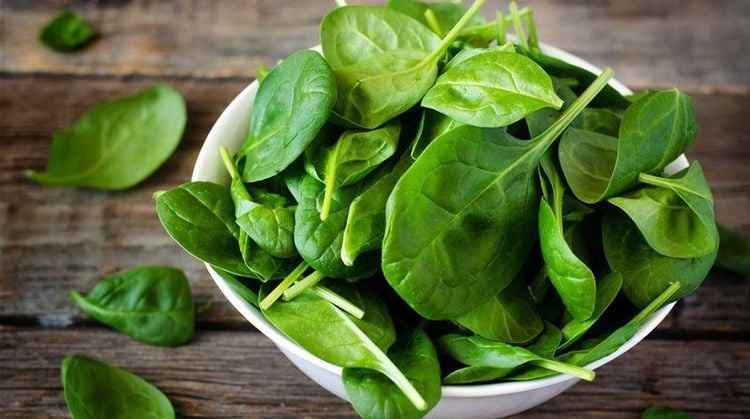
Rau bina chứa lượng lớn Folate cần được bổ sung cho cơ thể
3.2 Vitamin D This fat-soluble vitamin that helps absorb calcium to support strong teeth and bones may also help protect against cancer. Researchers believe that vitamin D inhibits the growth of cancer cells.
A report presented at the latest meeting of the American Association for Cancer Research (AACR) shows that there is a link between increased vitamin D intake and reduced risk of breast cancer, vitamin D to reduce risk develop breast cancer up to 50%.
According to a 2005 Harvard study, vitamin D can also improve survival rates in lung cancer patients. Although vitamin D is often combined with milk and eggs, high concentrations can also be found in seafood dishes such as cod, shrimp, and salmon.
4. Fiber Fiber aids in the faster movement of food through the digestive system. Fiber helps foster a healthy community of bacteria that live in the digestive tract. This community is called the microbiome.
A healthy microbiome reduces the risk of cancer. Foods with fiber include: Whole grains such as barley, oats, kamut, bulgur, corn, psyllium, and rye, whole grain breads and pastas, legumes, and root vegetables and fruit.
5. Cancer risk in protein foods and alcoholic beverages Protein present in foods of animal origin is mostly absent from the diet. Includes meat, fish, poultry, shellfish, dairy products and eggs. However, red meat and processed meat are the most concerned about cancer risk. Red meat includes pork, beef, veal and lamb. Processed meats like bacon, ham, jerky, and hot dogs.
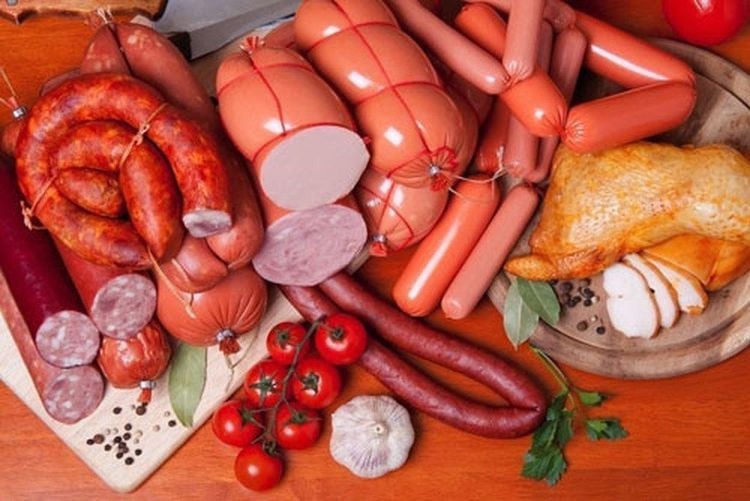
Một số thực phẩm chế biến sẵn làm tăng nguy cơ ung thư khi sử dụng
Alcohol and alcoholic beverages increase the risk of developing certain types of cancer. The risk of developing these cancers increases the more alcohol or alcohol a person drinks, especially over time.
Alcohol drinkers have a higher risk for cancers of the larynx, esophagus and oral cavity because these tissues are directly exposed to alcohol when a person drinks it. Alcohol increases the risk of cancer because it contains two chemicals that can damage the DNA of healthy cells: Ethanol, the main ingredient in alcoholic beverages, and Acetaldehyde, which is created when alcohol is digested by the body. . In addition, alcohol can affect the breakdown of the hormone estrogen, increasing the amount of estrogen in the blood. Having more estrogen in the body than usual is a risk factor for breast, ovarian, and uterine cancers. This is a particular concern for premenopausal women and women taking menopausal hormone therapy.
Customers can directly go to Vinmec Health system nationwide to visit or contact the hotline here for support.
Articles refer to the source: webmd.com, cancer.net





